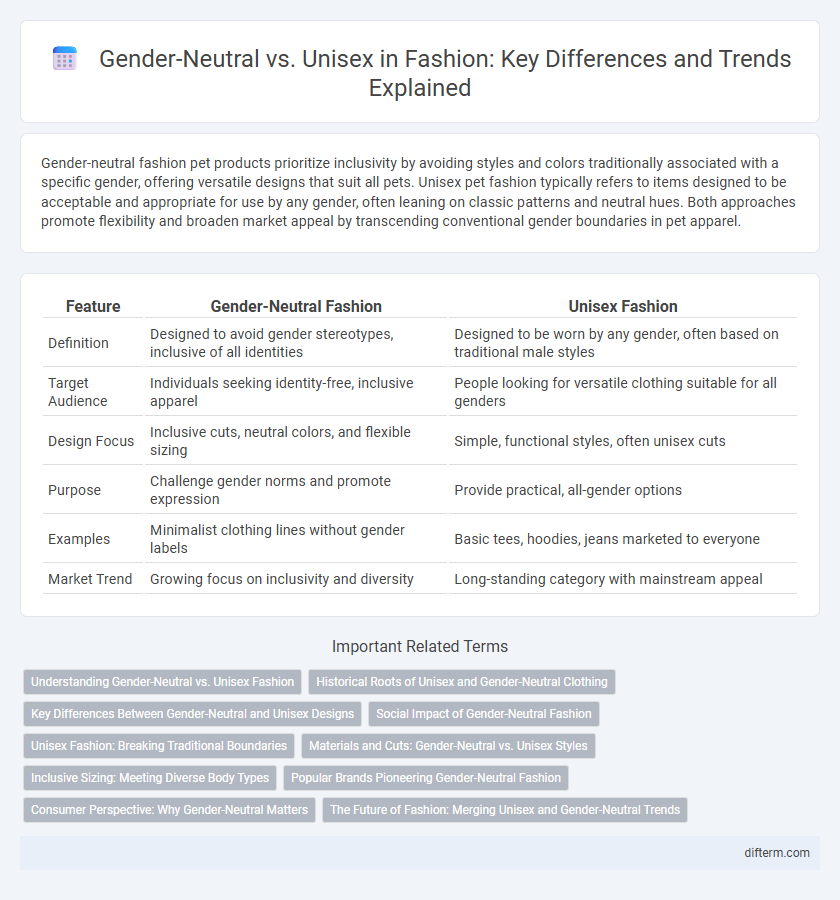Gender-neutral fashion pet products prioritize inclusivity by avoiding styles and colors traditionally associated with a specific gender, offering versatile designs that suit all pets. Unisex pet fashion typically refers to items designed to be acceptable and appropriate for use by any gender, often leaning on classic patterns and neutral hues. Both approaches promote flexibility and broaden market appeal by transcending conventional gender boundaries in pet apparel.
Table of Comparison
| Feature | Gender-Neutral Fashion | Unisex Fashion |
|---|---|---|
| Definition | Designed to avoid gender stereotypes, inclusive of all identities | Designed to be worn by any gender, often based on traditional male styles |
| Target Audience | Individuals seeking identity-free, inclusive apparel | People looking for versatile clothing suitable for all genders |
| Design Focus | Inclusive cuts, neutral colors, and flexible sizing | Simple, functional styles, often unisex cuts |
| Purpose | Challenge gender norms and promote expression | Provide practical, all-gender options |
| Examples | Minimalist clothing lines without gender labels | Basic tees, hoodies, jeans marketed to everyone |
| Market Trend | Growing focus on inclusivity and diversity | Long-standing category with mainstream appeal |
Understanding Gender-Neutral vs. Unisex Fashion
Gender-neutral fashion emphasizes clothing designed to transcend traditional gender categories, promoting inclusivity by embracing diverse identities and expressions. Unisex apparel specifically refers to garments crafted to be suitable for any gender, often featuring neutral cuts and colors without explicit gender markers. Both concepts challenge conventional fashion norms but differ as gender-neutral fashion advocates for broader cultural acceptance, while unisex tends to focus more narrowly on practical, inclusive wearability.
Historical Roots of Unisex and Gender-Neutral Clothing
Unisex clothing emerged prominently in the 1960s and 1970s counterculture movements as a rebellion against traditional gender norms, with designers like Yves Saint Laurent introducing androgynous styles. Gender-neutral fashion, rooted in broader social justice efforts, seeks to blur or eliminate distinctions in clothing based on gender identity, reflecting evolving cultural understandings beyond the binary. Both trends trace their historical roots to challenges against conventional fashion, yet gender-neutral clothing specifically addresses inclusivity for non-binary and transgender individuals.
Key Differences Between Gender-Neutral and Unisex Designs
Gender-neutral designs prioritize inclusivity by avoiding traditional gender-specific styles, focusing on versatile cuts, colors, and fabrics that suit all identities. Unisex designs often adapt existing gendered clothing to fit both men and women but may retain elements traditionally associated with male or female fashion. Key differences lie in intent and approach: gender-neutral fashion challenges societal norms by creating entirely non-gendered apparel, while unisex fashion offers practical, shared options within conventional gender frameworks.
Social Impact of Gender-Neutral Fashion
Gender-neutral fashion challenges traditional norms by promoting inclusivity and reducing gender stereotypes in clothing, fostering a more accepting society. The rise of gender-neutral brands and collections encourages self-expression without the constraints of binary gender roles, contributing to social equality and mental well-being. Consumer demand for gender-neutral apparel drives industry innovation and supports diverse representation in fashion campaigns and runway shows.
Unisex Fashion: Breaking Traditional Boundaries
Unisex fashion challenges traditional gender norms by offering versatile clothing designed to be worn by all individuals, regardless of gender identity. This inclusive approach emphasizes comfort, functionality, and style, breaking down rigid societal expectations associated with gender-specific apparel. Brands embracing unisex fashion capitalize on a growing demand for diversity and self-expression in the modern fashion industry.
Materials and Cuts: Gender-Neutral vs. Unisex Styles
Gender-neutral clothing emphasizes inclusive materials and cuts designed to fit a broad spectrum of body types without traditional gender distinctions, often utilizing stretch fabrics and adjustable features for versatility. Unisex styles typically adapt conventional cuts from one gender and offer them in neutral colors and sizes to appeal to all, but may retain elements tailored to specific body shapes. Fabric choices in gender-neutral fashion prioritize sustainability and comfort, while unisex pieces usually focus on standardized sizing and mass appeal.
Inclusive Sizing: Meeting Diverse Body Types
Inclusive sizing in fashion addresses diverse body types by offering gender-neutral and unisex options that transcend traditional male and female categories. Brands incorporating extended size ranges and adjustable fits promote accessibility and comfort for all wearers. This approach fosters inclusivity by recognizing the unique needs of every individual regardless of gender identity.
Popular Brands Pioneering Gender-Neutral Fashion
Popular brands pioneering gender-neutral fashion include Telfar, known for its inclusive sizing and unisex handbags that challenge traditional gender norms. Gucci offers genderless collections blending masculine and feminine styles seamlessly, appealing to diverse audiences. Other influential labels like Rad Hourani and Wildfang create versatile garments designed for all genders, promoting equal expression and breaking binary fashion barriers.
Consumer Perspective: Why Gender-Neutral Matters
Gender-neutral fashion prioritizes inclusivity by offering designs that transcend traditional gender categories, appealing to a broader consumer base seeking self-expression without restriction. This approach addresses the demand for authenticity and comfort, reflecting evolving social attitudes around identity and equality. Consumers increasingly favor gender-neutral options for their versatility, sustainability, and alignment with progressive values.
The Future of Fashion: Merging Unisex and Gender-Neutral Trends
Fashion's future embraces the fusion of unisex and gender-neutral trends, dissolving traditional boundaries and promoting inclusivity across all identities. Brands increasingly adopt versatile designs and sustainable practices that cater to diverse body types and personal expressions, reflecting society's evolving understanding of gender. This shift not only challenges conventional norms but also drives innovation through adaptive fabrics, customizable fits, and inclusive marketing strategies.
gender-neutral vs unisex Infographic

 difterm.com
difterm.com